How to paint your own home, with instructions. LONG
How to paint your own home, what to buy, what order to do things, and how to do the things.
You will need
- Dropsheets/drop cloths - can be old bed sheets doubled over, towels, you can really use anything if you have enough of it
- Paint brushes - generally the more expensive horse hair brushes are better, but for amateur use a synthetic brush (cheap)
- Paint Rollers - You can buy a pack of 10 rollers for about $20 at the hardware store, you will need medium > fine 14mm > 12mm nap, and also a small extendable roller poll for the roller handle which you will also buy (screws into pole - sleeve goes on it)
- Plaster & builders bog - plaster for the finer work, and builders bog to get a deep hole or crack filled and dry quickly.
- Sand paper & sanding block < sanding block important, get the one with the screws at either end to clamp it down
- No more gaps - WATER BASED no more gaps for cracks etc.
- Stirring stick, can be just a piece of wood - no screwdrivers it will not do the job properly, you need something about an inch wide
- Paint
- some empty buckets & painters pales which are about 4L in size We will have oil and water buckets seperate
- Turpentine 1Litre
- Plaster breadknife / scraper. Likely one about 4 inches wide for plaster work, hopefully you won't have to do a heap of this.
- Roller Tray x 2, i prefer 10" rollers rather than the 12" wide rollers as they are easier to work with
- Sugar Soap
- Broom
- Caulking Gun for no more gaps
- No more gaps - ACRYLIC / WATER BASED
- Small Step Ladder enough to reach the ceiling from the 2nd rung.

The painters pales are the one shown in this picture on the tiles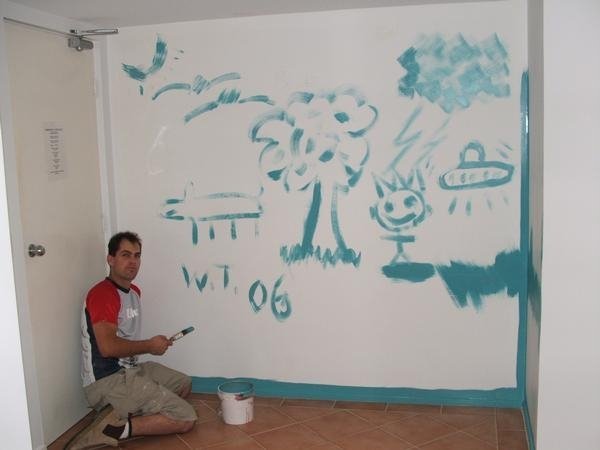
For paint selection you will have to match the colour I have included a video here on a very basic way to match colour, another way is to dig a chunk of about 2 inches of the wall colour out of the wall with a knife and take to the paint shop and they will computer match it. It is better however, to match it to a pre-defined colour swatch of one of your preferred brands, as when you go back for a different quantity of paint they will be able to match exactly. If you only intend on buying the same 4L tins, or 10L tins of paint each time, digging out of the wall each time will work.
Colour matching can be done as follows:
You will generally have 3 colours for a home without it looking absolutely ridiculous - now don't go and pick 4 different colour feature walls it will look SHITE trust me, just stick with 3 for now, trust me you have absolutely no idea what you are doing at this point.
Painting is one of the most under appreciated trades, which I've seen apprentices do for years and years and still not be able to do a decent job of it, so if this is your 2nd house or even you're 6th house you will not be able to deviate from these instructions until you have painted THOUSANDS of homes. This is the experience I have and I am telling to you now. Take my word for it !!! Another word of warning, the guy at the paint shop is only a marginally crappier painter than you, he's likely not done any work in the trade and has to rely on the information on the brochure to tell you - SO HE KNOWS LESS THAN NOTHING !!! word of warning.
The colours you will pick, if you intend for your home to be modern (interior) will be
Ceilings - 1 x 15Litre drum(4 bed house)
Ceiling white - you can just pick up an untainted 15 Litre ceiling flat, that will do an entire 4 bed house ceiling with left overs, you can use this in a VENTILATED bathroom, that is a bathroom with an exhaust fan or good air flow, otherwise for bathrooms generally a satin or a full gloss is preferred but not essential.
Walls - 2 x 15Litre drums (4 bed house)
Low sheen Interior - This paint has a slight sheen for cleaning and wiping, and lastability this is typically what will be put on walls.
Trim / Door frames / Doors / Window fames / Skirts - 1 x 10L gloss, and another 4L gloss tin (4 bed house)
Full Gloss interior acrylic - This gives the important features a shine and makes them stand out, also cleanability as its likely the place that will see hands touching. It will also show your dodgy brush work, so try to keep brush strokes in line, and do an entire face of a surface from start to finish. I will show a video of the gloss work.
STAIN SEALER UNDERCOAT - 1 x 4L tin
You will need a stain sealing undercoat, the one I show in this video is the best you can buy in acrylic. If you cannot buy a decent acrylic stain sealing undercoat, use an OIL based FAST DRY.
To save time if you want to do less coats, get your undercoat pre-tinted to the same colour as what you are doing, so if you want gloss - usually white, then leave it as is, or if you are going with beige walls, tint it to that colour. That way when you are undercoating, the first coat will closely match the 2nd coat and you might even be able to do it in 2 coats (i doubt it because most of you will still have no idea what you are doing even after reading this)
The very first thing you will have to do is brush down any cobwebs from cornices, skirting, door jambs, etc. Wherever you are going to be applying paint to, its a good idea to clean the shit off it... As you are going around doing this, start noticing where the cracks are in everything, they will likely be in the corners where cornices meet, and particularly on and around door jambs, skirting, window frames etc.
Once you have cleaned all the basic crap off, its time to inspect and see if areas need cleaning, they often do not so i would caution as to not do more than you need to. The main areas that will need a clean, are around door handles, sides of door frames where hands hit and anything on walls from about knee height to head height that looks a bit grubby. It will be similar for small repairs down the track.
If you have a greasy area, scrub the area (not too hard, with sugar soap a few times on the area only. It is nearly almost unnecessary to scrub an entire house with sugar soap for two reasons. 1. You have to clean the sugar soap residue off before painting (another cleaning) 2. The majority of the wall surfaces generally stay fairly clean over the years unless you are a crack head and live in a tip - which i have come across more often than i would like to. Heroin addicts are great fun as there is little blood spots on the ceilings and walls from when they pull the needle out (hence stain sealer which you have already bought thanks to me being a Dr. of painting)
So clean the grubby areas, dust down the rest, and clean the sugar soap off the walls after its dried with plain water.
Some of my work...

If you have a mouldy area, like a laundry wall, you can mix 50% bleach, and 50% water into a spray bottle, and spray the wall / ceiling area a few times and it will eat the mould. Wear eye protection if going overhead, as this actually burns and can scar your eyes, and doesn't feel nice.
So once everything has been cleaned down, its time to identify any stains around the house, and seal them with the stain sealer. These will be often on cornices, little spots, crayon, hi-lighter pen, Ball point pen marks, even dark pencil marks. Put about a 1/4 Litre of stain sealer into a painters pale and go room by room sealing up the stains. Brush over them with the sealer and brush out so you are not leaving thick brush marks on the walls when dry.
After you have done this, assuming you have done the ceilings / walls, you will HAVE TO spot prime the stain patches with the respective finish colour of the walls / ceiling. So if it is the ceiling paint, you will have to go around and spot prime all the areas you have done with the stain sealer - this can be done with the roller an hour before you roll the ceiling, Just understand it is important to paint OVER the stain sealer, because the sheen of the ceiling paint won't match the sheen of the stain sealer and will likely be a very different colour if its un-tinted.
Always stir the paint thoroughly before using using the stirring stick. make sure to get the bottom of the tin stirred up as thats where the tinters will sit if the tin has been sitting for a while. If you have just returned from the paint shop and they have used the paint shaker at the shop, there is no need to stir if you start painting that day. Any other time, stir the paint first, otherwise you may end up painting your house 3 different shades of the same colour.
Some more work i've done over the years.
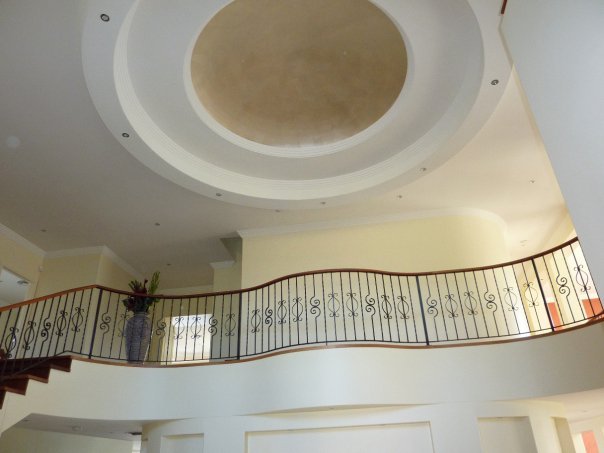
IMPORTANT - IF YOU ARE TIPPING PAINT FROM A LARGER TIN TO A SMALLER ONE OR PALE, TIP HALF THE CONTENTS INTO A BUCKET OR OTHER CONTAINER FIRST, AND THEN POUR FROM THAT CONTAINER INTO YOU'RE PAINTERS PALE. This will save a lot of mess. Use the brush to wipe the edge every time after a pour. Always cover paint, don't leave the lid off. A shower cap over the painters pot, leaving the brush in is a good way to go to lunch and easily pick up later on.
The next step is to go around and use NO MORE GAPS
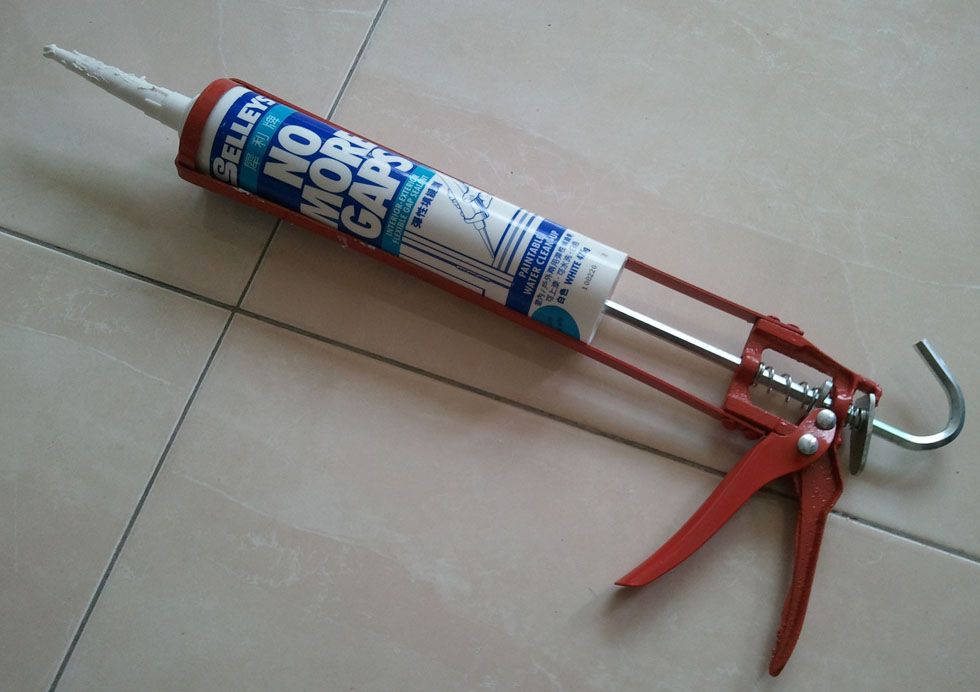
You will have to saw off the end of the threaded end of the tube, and put on a plastic nozzle which you usually are handed at the checkout, sometimes they leave a bin around with 100's in it, grab several nozzles. Once you have sawn the end bit off (leave the thread) then screw the nozzle onto the end. Then make the end hole of the nozzle slightly larger about 1.5mm should do. If you go too big, just unscrew and use another nozzle (let pressure off gun first or MESS).
Just a rough idea of using a gaps gun, you gap a line, and wipe with your finger. I personally then wipe finger on the side of the gun and let it dry, and consistently use the same finger. Its water wash up, when it dries on the caulking gun it can be cut off later. This looks messy and i get other painters commenting on it, but its 5 x faster than the way they do it.
Go around the propery and do the ceilings first, gaps in corners of cornices are the first culprits and there will be plenty of them. Next will be gaps between where the cornice meets the ceiling and walls, every so often you'll see a hair line crack that might go for a few feet. These are things that paint WONT fill, so you need to gap all these cracks first. Get a system going, either do the whole room, or do all ceilings room by room, then all walls room by room, and then all trim room by room.
Once you have done all that, and you'll probably want to spend at least the morning looking for these, you can move to the next step which is making small repairs on dents etc. on the walls / ceilings. These will have to be spot primed with the FINISH COLOUR - technically this is wrong, and should be undercoated first, but i find its the best way to not have the repairs show through to the finish coat.
This is one technique i recommend for an amateur, as you won't be able to spot half the patches you do, BUT the drawback of this is more sanding. If your walls are already grey or beige / brown, then using white plaster and putting a thin coat on will be fine as you will be able to see it because of the different colour.
So go room by room again, ceilings also, and repair any dents that are obvious. The general rule of thumb is slightly above eye level, and down to knee level across the entire home, as its the most obvious point for the eyes to see when walking around. Next there might be some bigger dents down lower or higher that might stick out no matter what. So to do them quickly, you use the builders bog to start which has a hardener and material, and majority do the repair with that, finishing off with the regular wall plaster over the top of the bog to make for a smooth finish.
Once you are confident you are happy with the work, you can proceed to sanding and priming the patches. So using the block which i told you to buy, apply a medium grit piece of sandpaper to it and sand all the spots until you cannot feel them any more. Its best to take the paint you will be using for spot priming around with you, as you can do several patches, and then prime several patches so you are not missing any. Believe me if you do miss them you will notice, but it is not the end of the world and i can show you how to fix it later.

So at this point you have probably done about 70 - 80% of surface preparation to be ready to actually start painting.
SO... The first two things you will do, is to paint the CORNICE and the SKIRTING along the bottom of each wall, If you want you can also undercoat the door jambs and doors at the same time, this will SIGNIFICANTLY add to the time it will take to finish undercoating by which time you will be phoning a professional. So i recommend doing the Cornice and Bottom Skirting (around walls) ONLY.
The cornice will be ceiling flat, in usually white, so you will brush one cornice at a time, with a roughly 4 inch brush, or even a 6 inch wide brush. The way this is done is take about a 0.25L (moving to a 1/4 L when you are more confident) and brushing one run of cornice from start to finish. This can be difficult to see as often its white on white, so again you will have to get a system going and work like a robot, that is repeating the same motions over and over to get a perfect finish (or average to shit in your case - but you will delude yourself that you are saving money so continue on)
Here is the girl from bunnings showing you one way and another guy showing you also
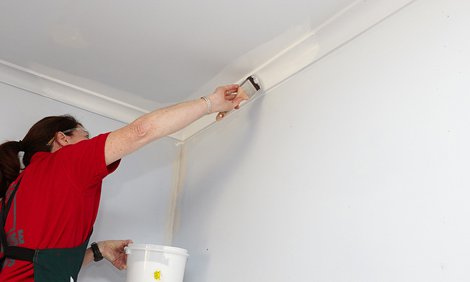
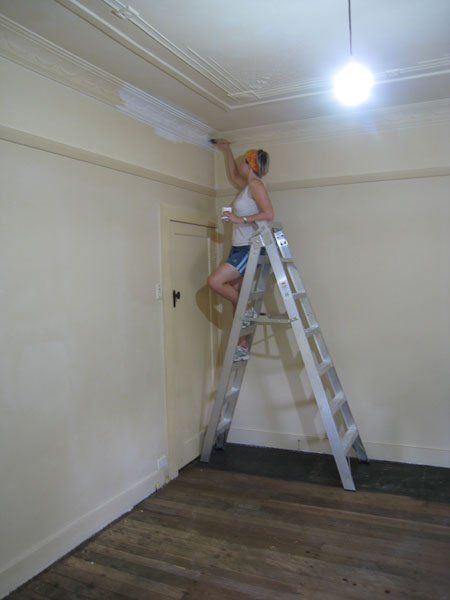
Starting in the corner of the cornice, brush some paint from the corner and up onto the ceiling in a stabbing motion to get into the corner, then paint the top half of the cornice right to left about 2 feet along, then do the same stabbing motion for the bottom of that same piece of cornice again about 2 feet along, then move your ladder, and start again. Top half, bottom half. The paint can go onto the ceilings or walls, it will end up being the cutting in for the ceiling so ideally a couple of inches on the ceiling or at least an inch is preferable. Go room by room and do the ENTIRE cornice right through the house. Get this out of the way so then you can do either the walls, or ceiling, or trim next in any order.
Once you have painted the cornice, then you can either roll out the ceilings, or start on the walls. It is nice to get the ceilings out of the way and you will see an immediate benefit from doing this BUT you might be impatient like most people and want to get painting some walls.
This picture shows the correct BODY ORIENTATION for rolling a ceiling, believe me if you get this wrong it will break even the hardest brickies back so, the way to do it is stand under where you want to roll, and roll in the same direction as you're shoulders. So side to side, about 1.5m at a time, do a square get a good coverage, then move over and do another square. Paint like a robot. If you roll pushing towards and away from you're body its very hard on your back. doing it the first way is easy.

Once you have rolled the ceilings, you can move onto undercoating the skirting (bottom of wall). Using you're undercoat, brush all the skirting along the bottom of the wall, you do not have to be too fussy at this point, as it is only undercoat, its down low, and there will likely be 2 coats of gloss going over the top.
After that, put the first coat of gloss over the skirting, even when you're done, do the 2nd coat as well. Again you should be able to move fairly fast with this, as you can get it on the walls and its going to get painted over anyways.
So Now we can start the walls. So to do that, you have to 'cut in' the walls with the chosen finish colour. Now technically the correct way is to cut a wall, and roll a wall to finish it - i have more important things to do so I choose to do it my way and continue living my life. So cut in each room once, go room by room, until all the rooms are cut in.
Here is another video showing cutting in besides window frames, which is often gloss but I find nobody see's this edge, so this is the way i've always done it, never been picked up on it (only other painters) This is the easy / fast way.
You can either being rolling, or just go around and cut them all in again. We are going for 1 coat on the ceiling (if the buildings already had paint on it) and 2 coats on the walls, 1 coat undercoat & 2 coats gloss on the trim. If its a new house, we would be undercoating all new surfaces first otherwise the paint won't stick. Probably should have said that earlier but assuming your house has been painted before.
Ideally don't cut in larger than about an inch and a half, around doors etc on the low stuff keep the cutting in minimal, around the bottom of a cornice you can make it about 2.5 inches for ease of rolling the walls later.
How to Roll the walls. This is the CORRECT TEXT BOOK METHOD for a perfect finish, If ANYBODY tells you a different method they are lying to you. This is less important for the first coat, but very important on the 2nd coat IF you are trying for top notch work.
The reasons for this have been explained in the video (i think from memory) basically you want to keep a wet edge on the wall, as you apply the paint to the wall it immediately begins to dry, so if you roll a 1m x 1m square, then above it another 1m x 1m square, what will happen is when its dry you will actually be able to see all these squares in the right lighting circumstances. Doing it the way i have shown in the video allows the paint to dry almost in one piece and should show no joins when dry.
When you are rolling I should mention about the LINES - If you are getting lines, this can be eliminated by a slight turning of the wrist in the opposite direction of the lines when rolling. You are just changing the way the pressure is applied to the roller. You should figure this out now i've said this. <----IMPORTANT
So at this point you have probably put a coat right through the household walls, and it will become obvious to you any patches that you have not spot primed. You will still be able to see ALL the patches, but the ones that haven't been spot primed will be more obvious. The easiest way to do this is to just roll those patches with the finish coat - ONLY THOSE ONES DONT DO THEM ALL OR WELL HAVE SHINY SPOTS EVERYWHERE. Take a drop sheet around with you, and have it over the spot you are rolling, and move it around with you. You can just shift furniture as needed / cover as needed, but you can generally get by with only a few bed sheets etc. If the carpet is going, go to town as mess won't matter.
Once you have done that, spots good, walls rolled once, you can just go and roll them again. The 2nd coat is the most important coat to get the rolling technique right on as this one is the one that will show the most.
IF YOU SPOT DAMAGE BETWEEN FIRST AND 2ND COAT DO THIS.
Ok you have just cut in twice, and rolled the walls once, and you have spotted several bits of damage that were not repaired in the prep stage. You can go around with plaster and fill them at this stage, then once they are sanded and dry, give them two coats with the roller allowing to dry in between. This will bring the sheen level up to close to what you have just done, and less likely to show through. Technically it should be 1 x undercoat 1 x finish coat, but i have found over the years that just coating the patches twice with the finish coat makes for a much nicer looking job. If you do the undercoat, then finish coat method you will likely see the patches even after the 2nd coat on the walls is done.
Then we are moving onto door frames / door jambs.
You HAVE TO undercoat all doors and frames before hand. Give the doors a rub down with the block using a finer sand paper to allow an etching to the surface.
The technique for rolling the doors is as follows, you can use a fine roller. This video technique can be used on both gloss and undercoat, but more important for the gloss.
& here is a video on how to paint a window frame, you can use the same technique for the undercoat and the gloss, though a lot more important on the 2nd and 3rd coats.
So now you are a really really shitty house painter, if you do it another 300 times, you might actually have SOME idea of what you are doing. We speed this method up using machines such as airless spray, machine sanding etc. But these are not for newbies that don't understand what is being done to begin with.
The time it would take me to finish a 4 bed 2 bath house would be between 4.5 to 5.5 days on my own, start to finish. That includes all prep, painting, cleaning up etc, for a near perfect finish.
If you as an amateur can paint your house in 4 weeks, you are going very well. I suspect even if you do start, you will find the job will drag on for months, and you will quickly work out why you should have paid a professional to do it in the first place.
Thank You & I hope I have helped you to some degree.
The Paint Ninja.
At Perfection Painting Pros, we understand the importance of a beautifully painted space. Whether it's your home, office, or commercial property in Charlotte, North Carolina, our team is dedicated to delivering top-notch painting services tailored to your needs. https://perfectionpaintingpros.blogspot.com/2024/02/unlocking-perfect-palette-factors-to.html